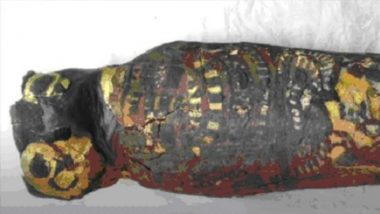A 2,100-year-old tiny Egyptian mummy long believed to be that of a hawk is actually a rare example of a near-to-term, severely malformed baby boy, researchers have found. The mummified foetus was mislabeled as "Mummified Hawk Ptolemaic Period" while being kept at Britain's Maidstone Museum. However, detailed micro-CT scans revealed that the mummy was of a male, stillborn at 23 to 28 weeks of gestation, and with a rare condition called anencephaly in which the brain and skull fail to develop properly.
The images show well-formed toes and fingers but a skull with severe malformations, said Andrew Nelson, mummy expert and Professor at the University of London, Canada. "The whole top part of his skull isn't formed. The arches of the vertebrae of his spine haven't closed. His earbones are at the back of his head," he said. There are no bones to shape the broad roof and sides of the skull, where the brain would ordinarily grow. "In this individual, this part of the vault never formed and there probably was no real brain," Nelson noted.
This foetal mummy is one of just two anencephalic mummies known to exist (the other was described in 1826), so far studied in the foetal mummy in history. Nelson recently presented the team's findings at the Extraordinary World Congress on Mummy Studies in the Canary Islands. "It would have been a tragic moment for the family to lose their infant and to give birth to a very strange-looking foetus, not a normal-looking foetus at all. So this was a very special individual," he said.
The research provides important clues to the maternal diet -- anencephaly can result from lack of folic acid, found in green vegetables - and raises new questions about whether mummification in this case took place because foetuses were believed to have some power as talismans, Nelson noted.
(The above story first appeared on LatestLY on Jun 02, 2018 05:09 PM IST. For more news and updates on politics, world, sports, entertainment and lifestyle, log on to our website latestly.com).













 Quickly
Quickly


